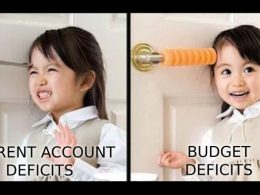Unlock the Editor’s Digest for free
Roula Khalaf, Editor of the FT, selects her favourite stories in this weekly newsletter.
I wasn’t running Asia ex-Japan funds in 1997, so I won’t count the Asia crisis that spanked economies and markets in the region and left many of my colleagues without a job.
So by my fingers I’ve worked through three mega-panics. The dot.com bust as an equity portfolio manager. The financial crisis while editing the FT’s Lex column. And I headed up research at a bank during the Covid-19 pandemic.
To the list we can now add the “Orange Crash” of 2025 (credit to my friend Roland for the genius name). I was also managing money when stocks and bonds dived in 2022 due to inflation fears. Ditto post-Brexit. Those weren’t full-scale freakouts, though.
This one is. The price moves are big enough, global asset classes affected wide enough, and a familiar pong of fear pervades. I don’t watch television any more, but I assume Jim Cramer is screaming his nut off as usual.
How then does the Orange Crash compare with historical meltdowns? And were there lessons gleaned from those previous crises that can help investors make sense of what is going on now?
The first point I would make from experience is that all crises are the same. They stem from asset prices inflating to insane levels and then popping. There are always reasons why high valuations are justified. When they plunge, something else is blamed.
On this occasion it’s tariffs. “The sell-off is driven almost exclusively by the policy change, and the implications the new tariffs have for company profits and economic growth,” writes a rival newspaper.
Yawn. And wrong. The Orange Crash is merely the latest in a long history of investors becoming ever greedier as markets rise over a prolonged period, before fear moves in to replace the narrative — as it inevitably does.
Of course, it is impossible to know ex ante what the pin in the balloon will be. Russia invading Ukraine? Nope. Climate-related financial risk. Ignored. Donald Trump’s election in November? Risk assets rose despite him promising tariffs.
So “liberation day” is not the cause either. It’s just the excuse. Mean reversion is the cause. And that’s actually useful. It means investors needn’t waste time following the tariff schmariff circus.
We can focus on valuations instead. As we always should. What asset prices remain too expensive? Have any investment babies been thrown out with the Orange Crash bathwater?
In aggregate, for example, even after a one-fifth drop, there are still no metrics by which the S&P 500 looks cheap — as my colleague Robert Armstrong explained clearly in his newsletter on Tuesday.
But that is not to say there won’t be scores of stocks that are oversold — even if tariffs depress earnings from here. In crises past, we analysts would set up a war room and screen thousands of companies searching for bargains.
It’s important to stay rational. This, I would say, is the second most important lesson from previous crashes. We were told in 2008 that housing was dead. During Covid experts said that no one would book a cruise ever again.
Forget the noise and crunch the numbers. Build in what you believe to be a maximum downside and trust your models. Nothing is as bad as it seems — nor as good. The Orange Crash will pass too.
Learning number three is shorter-term. And that is to never underestimate the power of ruling elites — especially on Wall Street. I covered the financial crisis from New York and was amazed at money’s hold over US politicians and policymakers.
In particular, the Federal Reserve. Its so-called reaction function was totally skewed to supporting shares versus deflating bubbles. A 15 per cent rally? Silence. A 15 per cent decline? Rates on hold or maybe a cut.
Hence not for me the dilemma many reckon the US central bank is currently in. Does it lower rates to calm markets or hold them to keep inflation in check? As losses mount, the phones ring. The Fed will fold.
Half a dozen billionaire financiers and businessmen have already criticised the tariffs. If Trump and Jay Powell can withstand the pressure, it’ll be the first I’ve seen in 30 years of investing.
My fourth tip is that something always blows when markets glow red. Whether it’s LTCM or Northern Rock or a US regional bank or Archegos — wild swings in prices plus leverage plus too-good-to-be-trueness equals ka-boom.
When that happens, we’re rarely near the bottom. The usual response is: “I’d never heard of such and such a security or product or company before. How did it grow to X trillion dollars without anyone knowing about it?”
Then investors are properly frightened. In other words, it is still way too early to be talking about buying on dips or returns to normality in markets. Either an explosion is yet to come, or this Orange Crash isn’t really a crash at all.
Which isn’t very useful when it comes to knowing what will happen next. That is why my fifth lesson from crises past is to hedge your bets. In case this is just a wobble, raise your exposure to risk assets in your portfolio by averaging down.
Meanwhile, make sure you own plenty of protection in the form of cash or bonds in case the Orange Crash has only begun. You can always increase your riskier bets once it’s clear the worst has passed.
Another hedge is overweighting your home currency. This is my final bit of crisis advice. When markets go mad, the only thing you know for sure is the denomination of your liabilities. You have to be able to afford your rent and groceries.
Or, more likely, a strong cocktail or two.
Source link









